Here's a look back at how wedding dresses evolved throughout the years. Know the trends illustrated by year along with the history and traditions reflected by these classic gowns.

The wedding dress is one of the most epic pieces of fashion that anyone will ever wear. It’s always a big moment when a wedding dress appears in movies or a TV show, signaling big changes for the characters involved. It means big changes in real life, too! But if you think that wedding dresses are an age-old trend with centuries and history behind them…you’re mostly wrong. Most of the wedding dress trends that are so important now are also really, really new.
Get a look at the illustrated history of wedding dresses and you may be surprised to learn just how modern these epic pieces of fashion really are.
Table of Contents
- Getting married
- circa 1040s B.C.E.
- circa 480s B.C.E.
- 1840
- 1850s
- 1860s
- 1870s
- 1880s
- 1890s
- 1900s
- 1910s
- 1920s
- 1930s
- 1940s
- 1950s
- 1960s
- 1970s
- 1980s
- 1990s
- 2000s
- 2010s
- 2020s
Getting married
The history of marriages is far, far older than the history of wedding dresses. Today, it’s extremely common for marriage to begin with a wedding ceremony. The wedding dress or dresses worn for this event are always a big deal. But when you look at where wedding dresses appear on the fashion history timeline, this is a pretty modern trend. For thousands of years, marriages were created without any sort of wedding ceremony…and with a wedding gown.
Marriage was and still is a contract between two people. And for many thousands of years, the signing of the marriage contract was done without any sort of ceremony whatsoever. There was no such thing as a wedding ceremony for most of human history.
The history of marriage
The ancient historian Herodotus wrote about the marriage market in Babylon. Each year, women were brought before the men of Babylon. The men would bid on them. The women who did not receive bids were given to poorer citizens, along with compensation to help pay for their care.
Bridal traditions
The cultures that appeared during the late Bronze Age and the Iron Age celebrated marriages with feasts. It was the fashion in ancient Rome for brides to wear a long veil in rich yellow hues. This symbolized flame, or light, to represent the light they would bring into their husbands’ lives.
Wedding ceremony
The idea of a wedding ceremony probably began in the classical world, during the days of ancient Greece and Rome. It was common in these days to hold a wedding feast and for the groom and the father of the bride to exchange vows and a handshake. As for the bride, she was also present.
Wedding ceremonies became more structured in the 1070s when actual laws were put forth in Europe that required blessings to be given to the bride and groom prior to any wedding ceremony. Secret wedding ceremonies were outlawed.
Elaborate feasts and ceremonies conducted by priests were common wedding celebrations during the medieval period. This is when the modern marriage ceremony began to take shape. The idea of a wedding day and a structured wedding ceremony full of events happened slowly over time. But what about the bridal gown?
It was common for hundreds of years for women to wear dresses at their wedding ceremonies only because it was common for women to wear dresses in general. Brides did not have a special gown made for their weddings until much later in history. For over 800 years, from around the year 1070 to 1840, brides wore the very best dress they owned for their wedding day.
The dress was any color or fabric, depending on whichever dress she owned that was her nicest. The idea of the white dress happened thousands of years after the first marriage ceremony was held.
circa 1040s B.C.E.
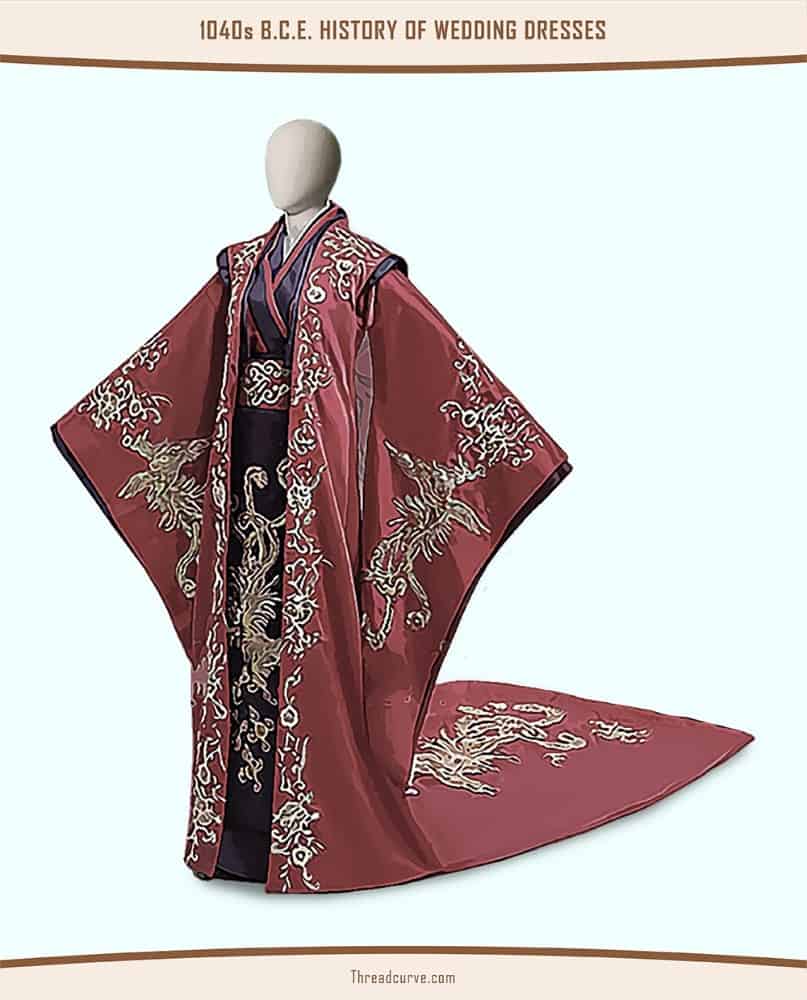
Both brides and grooms wore particular ceremonial outfits for their weddings during the Zhou Dynasty in China, which started around 1046 B.C.E. They wore black robes that were trimmed in red. There were many strict rules about clothing during the Zhou Dynasty, a very complete code of laws that dictated colors, cuts, and everything else about who wore what.
circa 480s B.C.E.
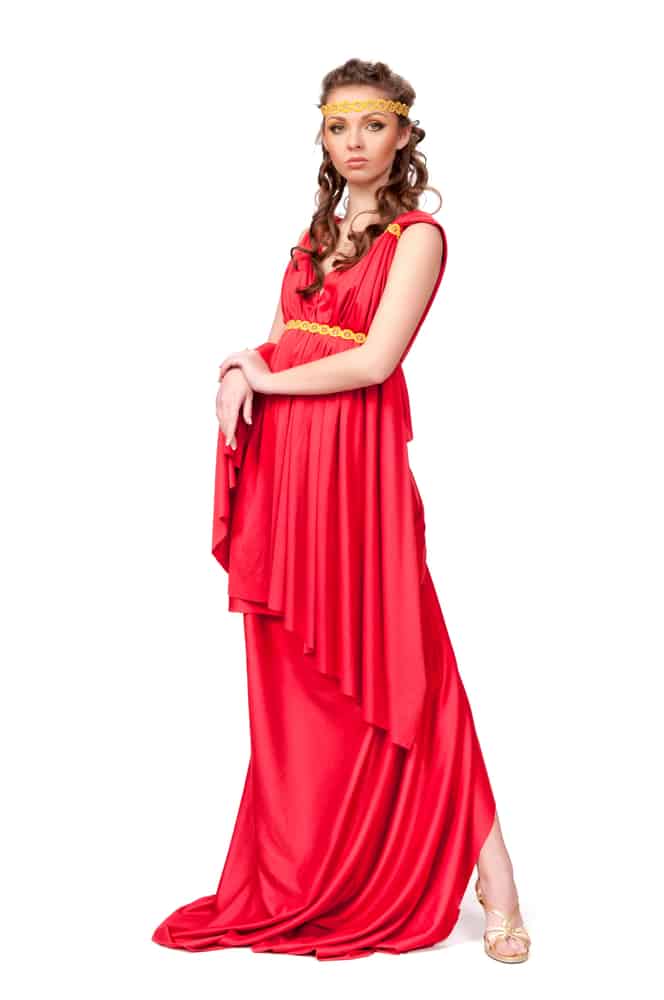
Women in ancient Athens did have a wedding gown tradition. They wore long robes in purple or reddish color tones that were cinched tightly at the waist with a rope-like belt known as a girdle.
The classical period in Athens lasted from around 480 to 323 B.C.E. In most cultures, it was not common to wear specific wedding attire. This idea is a relatively modern one.
1840

This was the decade that really set the tone for the modern Western wedding dress. In the modern Western world, it has become the fashion for brides to wear a white dress for their wedding day. This is all thanks to one white wedding dress worn by one woman: Queen Victoria. When the young Queen of England married her Prince Albert in 1840 in a white wedding dress, brides all over the Western world wanted to copy her style.
The dress
Queen Victoria’s white wedding dress was an elaborate creation covered with orange flower blossoms. It was a modern dress in its day, designed in the very latest fashion. That meant it had a tight-fitting bodice that emphasized the Queen’s waist with a big, full skirt that was made even larger with lots of petticoats underneath.
The dress was actually more of an off-white, but it is still the dress that inspired all of today’s bright white wedding dress looks.
A simple bride
The dress was absolutely fabulous and sounds very ornate but in fact, Queen Victoria’s wedding gown was a very practical and simple garment. Royal brides in the past used their gowns to show off their wealth, with many royal brides displaying a lot of jewels that were sewn right into the dress. One story from the 1400s in England tells of a royal bride whose gown was so heavy with gems, she had to be carried to the carriage that would take her to the church.
Queen Victoria wore a gown that much simpler by contrast, despite the fact that she was a very wealthy bride. Rather than jewels, her gown was bedecked with flowers and lace. Instead of a tiara, she wore a wreath of orange blossoms on her head. Her elegant, understated wedding attire set the world on fire.
Victoria’s dress, which was made with all British materials, was trimmed in Honiton lace. Made in a small town in Devon England, Honiton lace dates to at least 1568. After it was featured in Queen Victoria’s dress, the lace became a hot trend for wedding attire and clothing of all kinds.
The lace is still made to this day and is still added to wedding gowns more than 150 years after Queen Victoria’s wedding dress made it famous. The lace flounce on the dress, truly the most famous lace flounce in fashion history, was re-used for two other royal weddings, including that of the future George V of England.
Queen Victoria’s wedding dress was made of silk from East London.
The legacy
By 1849, women’s magazines were praising the white wedding dress as the look of choice for brides. Writers of the day claimed that white had always been the traditional choice for a wedding day dress, though this was not at all the case.
To this day, the big ball gown silhouette worn by Queen Victoria is a popular bridal gown choice. It has never fallen completely out of fashion for brides and it continues to inspire modern looks. That means that Victoria wasn’t just a wedding trendsetter…she was the queen of wedding trendsetters!
1850s
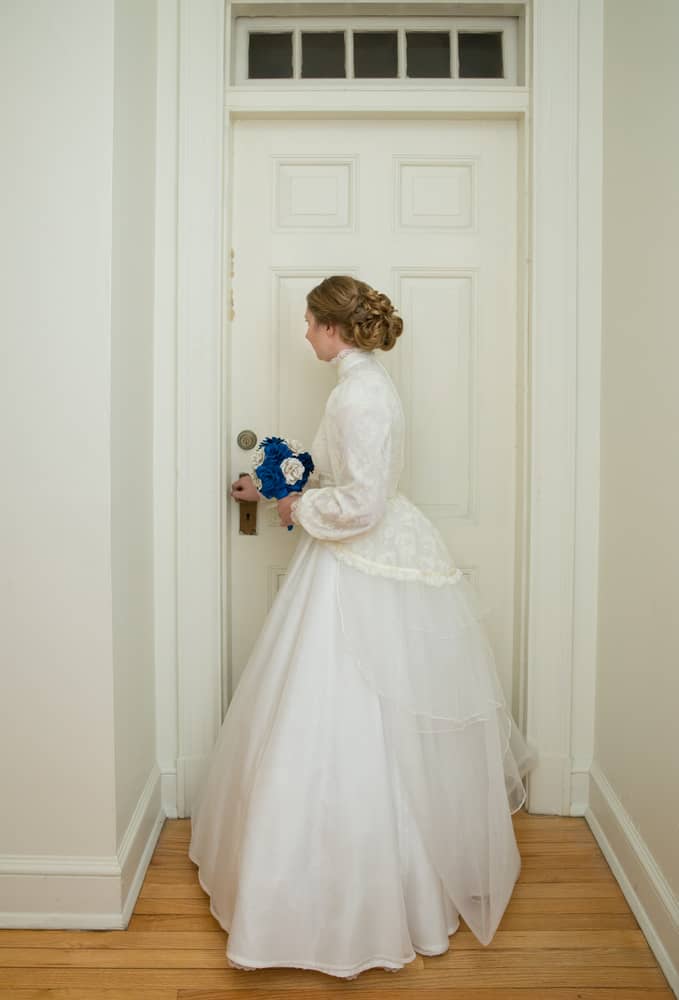
1856: Skirts got even bigger and took on the distinctive bell shape that would be popular for several years. The hoop skirt was introduced this year and made its way into wedding dress trends, too.
Gowns had fitted bodices with small waists at this time, achieved thanks to painful corsets made with boning. And that means actual bones, by the way. Whalebone was the most common type of corset. Skirts were worn to be very large and full over multiple layers of petticoats.
Wide collars made with lace were very in style at this time. Sleeves became fuller midway through the decade, made in blousy designs that cinched at the wrists.
1860s

Wide, scoop necklines became popular in this decade. Sleeves were flared and flounced with ruffles and lace. The wide bell skirts continued to be a popular silhouette but as the decade drew to a close, skirts began to narrow…at least on the sides. Skirts got bigger in the back, a look that would really make things weird in the decade to come.
Small collars made with white lace were in fashion. They were held in place with a brooch right at the throat, which became a statement piece late in the decade. Sleeves got fuller and wider, eventually taking on a bell shape toward the end of the decade.
1870s

Long trains were fashionable at this time. Necklines were wide and somewhat squared. Bodices were tight and waistlines were low to create an elongated look.
The wide, bulky skirts of the previous decade didn’t get smaller so much as they shifted. The bustle look came into fashion in this decade, a style that pulled most of the fabric of skirts and petticoats to the back. This created a big lump of fabric right over a woman’s rear end. No one can adequately explain how or why such a look caught on…but it did. Women of all social standing and monetary means wore this style.
It remains one of the greatest fashion mysteries of all time.
1880s

Wedding dresses, like all dresses of the day, were made with full skirts and high necklines. Long, somewhat fitted sleeves were also popular. Of course, the dress was worn with a pair of white gloves.
Bodices were tight and so were sleeves. The bustle was worn through most of the decade before it abruptly, and thankfully, disappeared from everyday fashion. The bustle continues to be used in wedding dresses, however, because this is a convenient way to bring a long train up to make the dress more wearable for a reception after the wedding. Many wedding dresses that have trains are designed to be tied up to create a bustle that will get the train off the floor so the bride can dance.
1890s
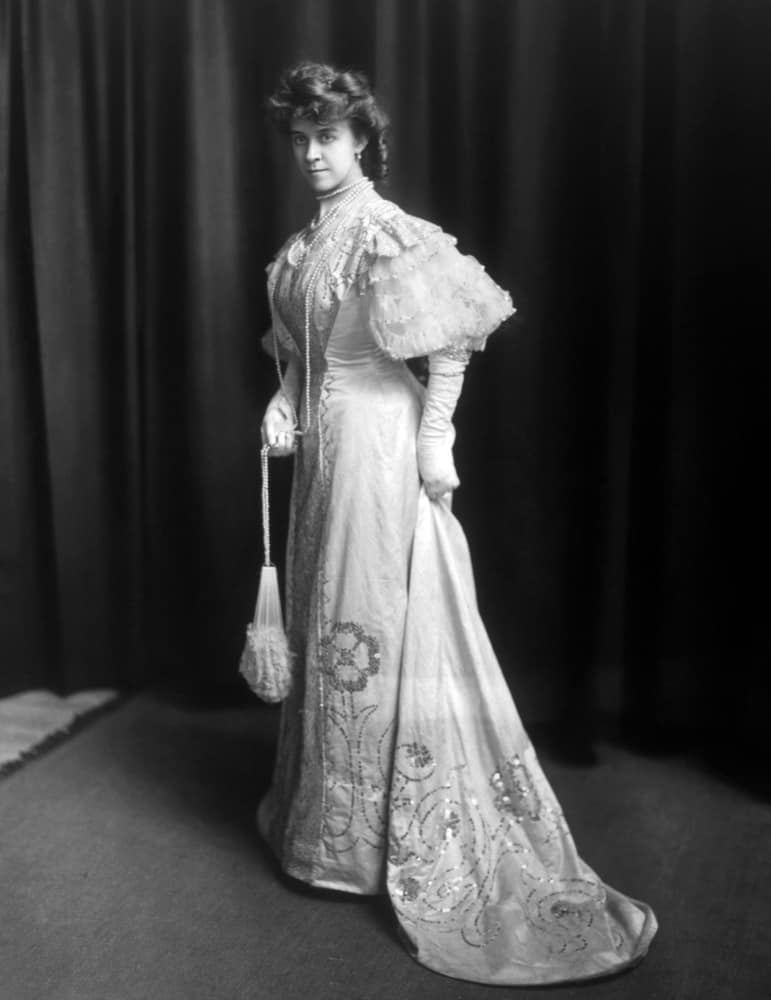
Sleeves became highly stylized at this time, with puffs at the shoulder and a slim-fitting cut from the elbow to the wrist. This was known, seriously, as the leg-o-mutton sleeve. Straight, A-line skirts were popular in this era.
Hourglass silhouettes were all the rage. The natural female shape became an inspiration for fashion, allowing women to be less restricted and stop using the corsets of the past.
The world was becoming modern. Electricity was now possible, allowing industry and manufacturing to be born. Garment companies were created and ready-made clothing was widely available for the first time. Women were able to spend less time sewing and more time living, which gave them new freedoms and opportunities that would help to shape the fashions and wedding dress design of the future.
The tulip bell skirt became popular in this decade. This was a distinct shape that was snug over the hips and then flared out to a wide hem.
1900s
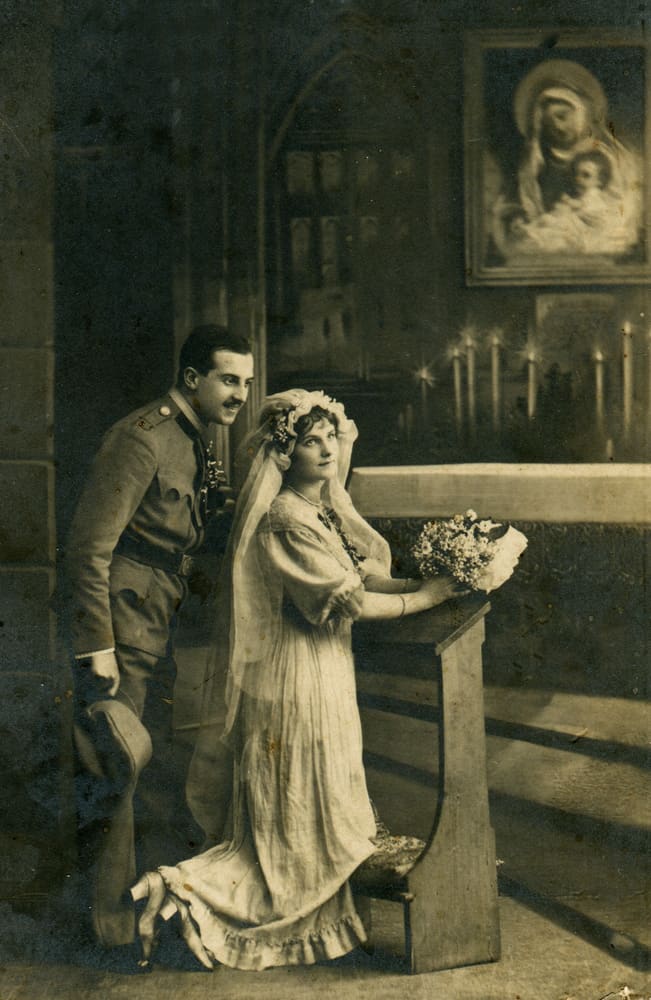
Dress styles, including wedding dresses, became narrower at this time. Small waist looks were in, achieved with corsets. Dresses had puffed sleeves, high collars, long trains and lots of frills. It was trendy to wear extremely long wedding trains that were several feet long. Lots of trimming, lace, embroidery and frills were added to wedding dresses in this decade.
Skirts began the decade fitted at the waist and flaring at the hem. Straighter skirt styles caught on later in the decade.
The bizarre S-shaped corset, known as the “health corset,” was worn at this time. This was created by a woman who had studied medicine. She recognized how unhealthy the standard corsets of the day were and re-designed the corset. It took the pressure off the waist and thrust and bosom forward and the hips back.
Obviously, this was an uncomfortable and unnatural position. But the shape did take root in fashion, creating hip-hugging skirts and lavish dress designs that showed off the new shape.
1910s
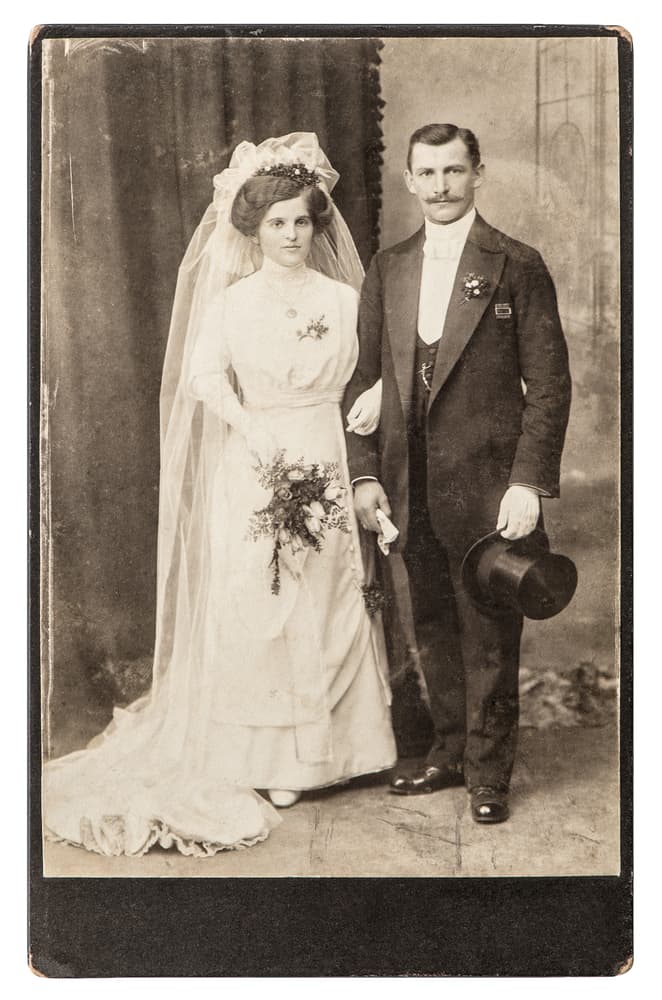
Dresses became somewhat looser in this decade, with waists not as tightly cinched. Corsets were worn less and less as dancing at weddings became more common. Dresses continued to have high collars, ruffles, and lots of lace looks popular in the previous decade as well. The natural female form was suddenly fashionable, which changed clothing. Dresses were a little less restrictive.
Wedding dresses were made with many tucks and lace embellishments. Sleeves were long and necklines high as a rule. Waistlines were high, rising to nearly empire height by the end of the decade.
1920s

Fashion changed dramatically in the 1920s as women broke away from the strict traditions of the past. Hemlines got shorter, waistlines dropped and nearly disappeared and style got bold. Fringe, bright colors, sequins, and flash suddenly appeared. Women were cutting their hair, going to dance clubs, drinking out in public, and in general, enjoying new freedoms for the first time in history.
Dresses were worn loose and straight and paired with floor-length veil designs. Like other styles of dresses in this decade, wedding dresses were made with dropped waists and looser fits that did not hug the curves. Scoop and V-neck looks were popular. For the first time, wedding dresses got shorter than ankle-length. Some women even wore dresses that exposed their knees!
The world was truly changing.
1930s
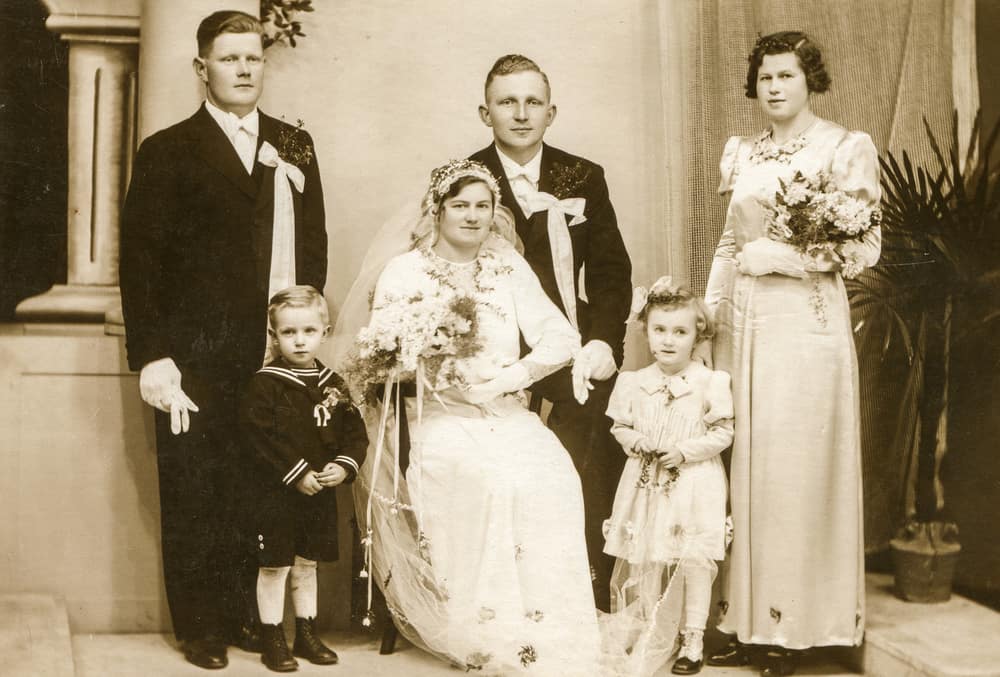
The Depression left little room for splurging on lavish wedding looks. Many brides during this time were wed in the best dresses they had to wear, similar to brides of a much earlier era. Dresses made specifically to be wedding dresses were simple and made in synthetic fabrics, which were more affordable than other options. Rayon was common.
For brides who could afford to keep up with the trends, dresses were somewhat more form-fitting than in the previous decade. They were made in simple designs that were not highly embellished. Smooth, silk looks were in, and white satin was a very popular bridal choice for the wealthy bride.
1940s
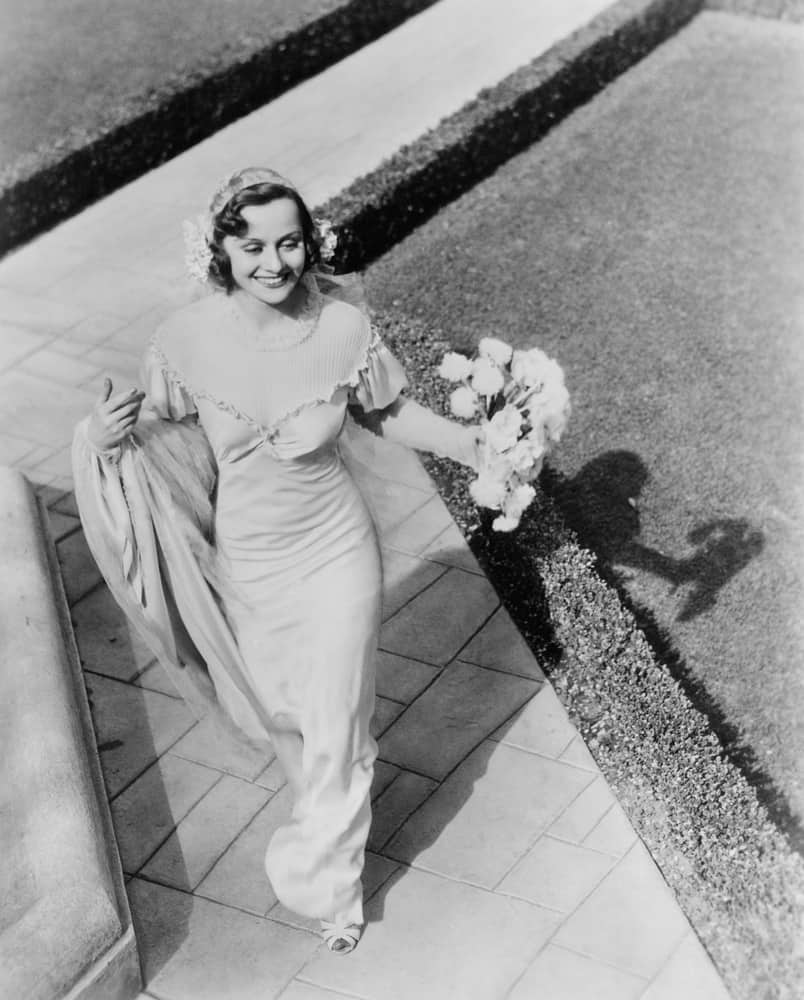
Times didn’t get any better in the 1940s when world war shook up the globe and created shortages across the country. Fashion was very simple and unadorned during this decade due to wartime shortages and rationing. Women saved by making their own wedding gowns. Some women were married in curtains, bed sheets, and furniture fabrics that were re-purposed.
Some WWII-era brides in this decade were married in their service uniforms. But brides who could follow the trends wore dresses with long, gathered sleeves and cinched waists. It was popular to wear V necklines and some were brave enough to wear bold, plunging necks. Dresses were often made in unadorned white satin in this decade.
1950s

1950: David’s Bridal opened as a local bridal fashion salon in Florida. As the years rolled by, David’s Bridal became one of the best-known names in wedding dress styles. They helped change the wedding game. Today’s bride usually doesn’t make her own wedding dress thanks to bridal salons like this one.
White, beautiful wedding dresses were back in the 1950s as the world emerged from the economic tough times of the Depression and the rationing days of the war. Big ball gown silhouettes came back into fashion at this time, and brides were happy to wear white dress styles again.
This was the first decade in history when it became more common for a bride to buy a special dress just for the occasion of her wedding. Until this time, the majority of brides wore a white dress they already owned or found a way to re-purpose their wedding dresses after the ceremony. But as the western world emerged from the economic stresses of the past and business boomed, brides wanted special dresses just for their big day.
Strapless dresses became popular in this decade. Sweetheart necklines were especially trendy. Calf-length wedding gowns became trendy after actress Audrey Hepburn wore one for her 1954 wedding. Big, full skirt silhouettes were back in a big way in this decade.
The most famous wedding gown of this decade is certainly the one worn by American actress Grace Kelly, who captivated the world when she married the Prince of Monaco. Her white wedding gown is still considered iconic and it continues to inspire royal wedding looks to this day. Kelly was married in a white dress with a high neck that had a tight bodice and sleeves made with lace and embellished with pearls.
It had a cinched waist and a full skirt. Princess Grace’s dress was made with a silk faille skirt and silk faille cummerbund paired with a lace bodice.
1960s
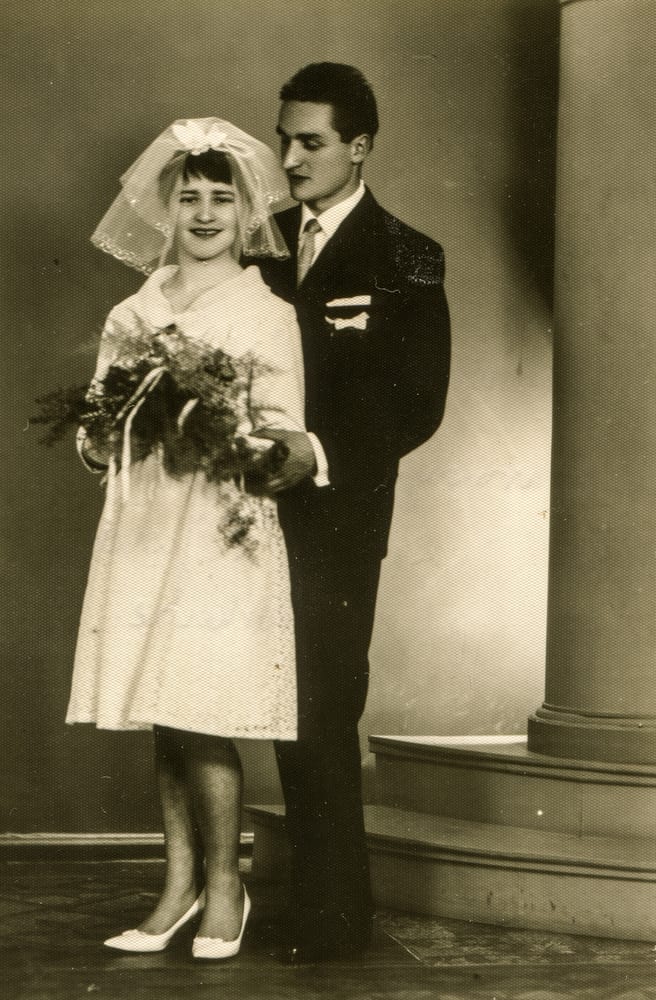
1960: Princess Margaret’s wedding was a huge event of the decade. Hers was the very first royal wedding to ever be televised. Hundreds of millions of people tuned in to see it.
Margaret wore a simple, elegant white wedding gown that continues to inspire wedding dress style looks to this day. Made with silk organza, the dress was designed to show off Margaret’s figure. This is why it was such a sleek, simple gown. It had long sleeves, a V-neckline that was just a bit risque (like Princess Margaret herself), and a fitted waist. The full skirt was a show-stopper, creating the traditional ball gown silhouette.
Slimmer dress styles came into fashion in this decade. Wedding dresses also got shorter and waistlines got higher. Empire waistlines were popular at this time. It was trendy to wear knee-length ad tea-length wedding dresses in this decade.
The dresses had cinched waists and flared skirts. Bare arms also made an appearance, sparking a trend that would re-appear in wedding dress design in future decades.
Column dress styles were popular in wedding looks at this time. These were sleek, slim, straight gowns that hung to the ankles. The miniskirt had appeared in fashion in this decade and some bold brides opted for this short hemline in their wedding gowns. Commonly, short wedding dresses were made with high necklines and long sleeves.
1970s
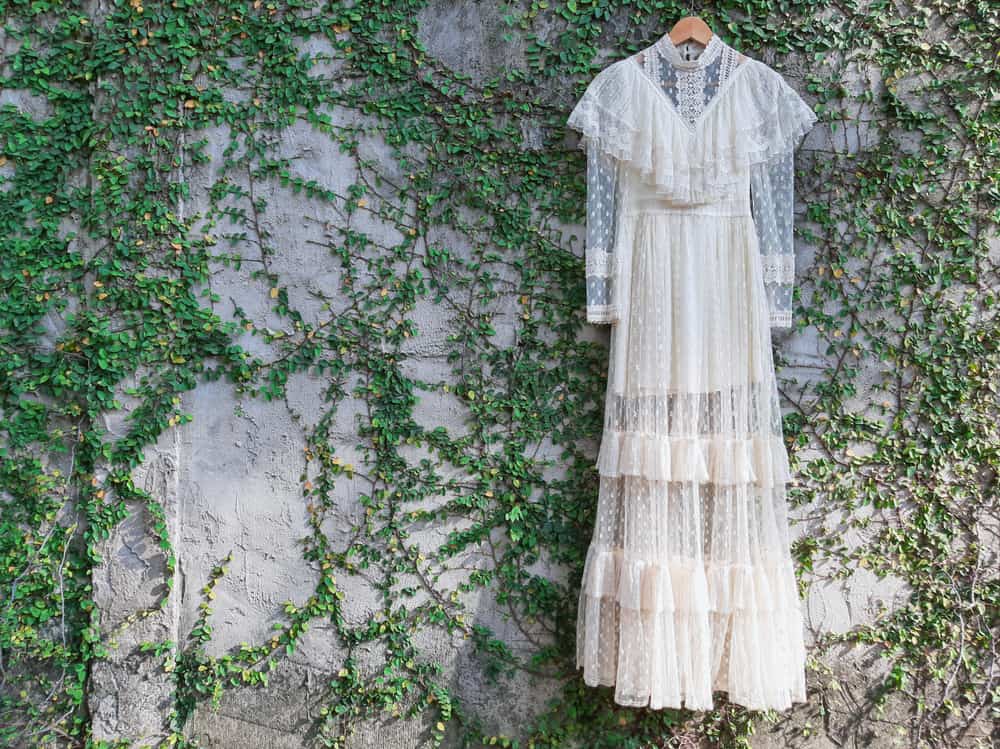
1973: Princess Anne, the only daughter of Queen Elizabeth II, was married at Westminster in this decade. Her incredible dress was a Tudor-style design with long trumpet sleeves and a long train. Anne’s dress had a full skirt and captured the flowy dress trends of the decade. The simple, elegant style captured by Princess Anne was mimicked by several future royal brides.
Loose, flowy, bohemian looks were popular in wedding dresses of this decade. Squared necklines were trendy, as were loose-fitting sleeves. Maxi-length dresses with ruffles were a popular bridal look. Softer fabrics, like chiffon, were a big part of bridal dress looks.
High necklines were in style for brides during this decade. Sleeves were large and flowy but often fitted at the wrist. Long trains were popular.
Lacy styles that were inspired by Victorian looks of the past were seen in this decade as well. But in this decade, bridal dress style was all over the place. Brides were into expressing their individuality and styles reflected many different wedding fashion options as a result.
1980s

After the counterculture revolutions in previous decades and simplified styles that ruled before, the 1980s exploded with fashion excess. All fashion was brighter, bigger, and more elaborate. And of course, wedding dresses were bigger and better than ever in this decade.
Large, princess-style gowns and ball gowns were hugely popular in bridal fashion in this decade, as were puffed sleeves. Layers and layers of taffeta, lace, and tulle were everywhere. The most famous wedding dress of the decade was the one worn by Lady Diana Spencer to wed Prince Charles. The iconic dress worn by Princess Diana continues to inspire wedding fashion style and it definitely set the wedding dress trends of the 1980s.
The Princess Diana wedding gown looked exactly like a fairy tale gown and it remains a favorite in the annals of fashion history. Every part of her look, from the dazzling tiara and veil to the shoes she wore, has been studied and recreated and used as inspiration for other wedding dress looks. The royal wedding of Princess Diana and Prince Charles continues to inspire modern wedding traditions and styles.
1990s
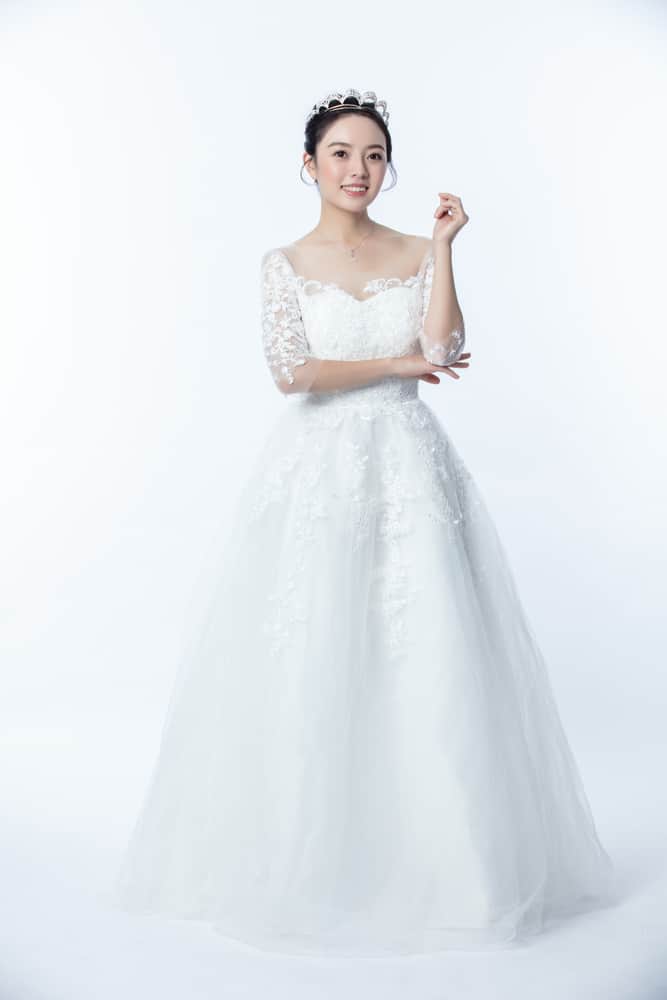
In sharp contrast to the poofy wedding dresses of the preceding decade, wedding dresses got sleek in the 1990s. Form-fitting gowns were the trend of the decade. Appliques were huge. They were plastered all over wedding dresses, adding lace, embroidery, and beadwork to the max.
Off-the-shoulder looks were popular in this decade and long sleeves were definitely in fashion. Hemlines were all over the place, from miniskirts to full ball gowns. Peekaboo styles incorporating two varying skirt lengths were seen during this decade as well.
2000s
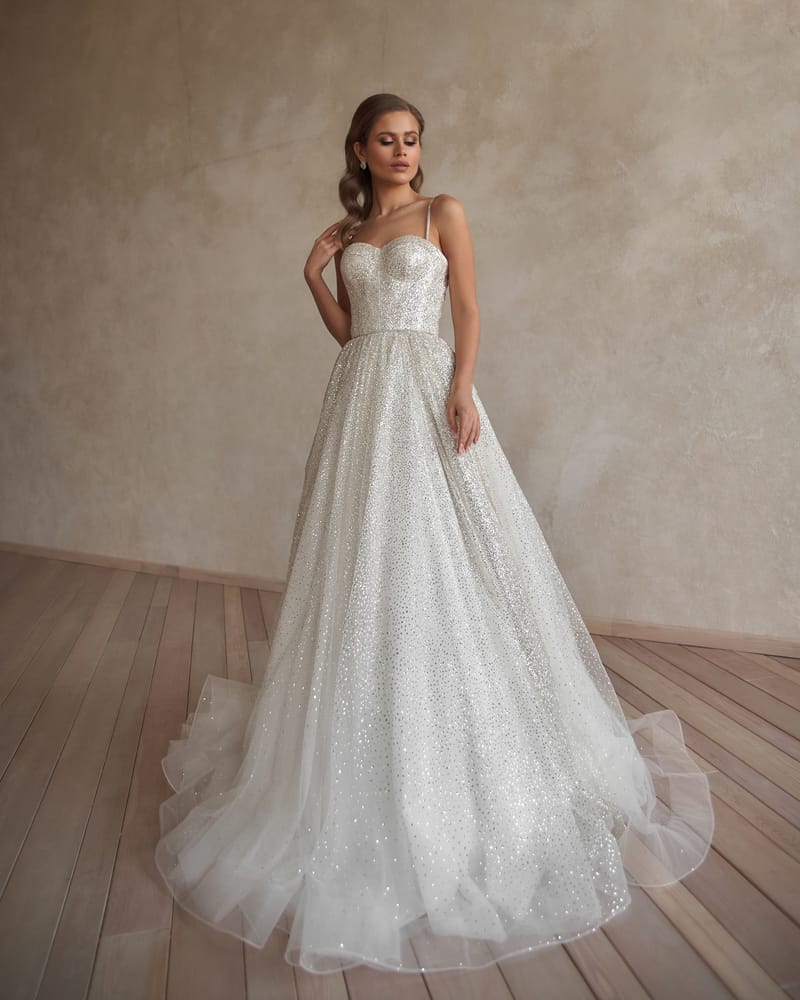
Strapless dresses were extremely popular in the 2000s. Sweetheart necklines became popular later in the decade. Rather than lace, lots of crystals and other “bling” details were used to embellish gowns.
Dress silhouettes were varied, though A-line gowns and ballgown styles were seen often. Slimmer styles also made an appearance, though this would really catch on in the next decade.
2010s
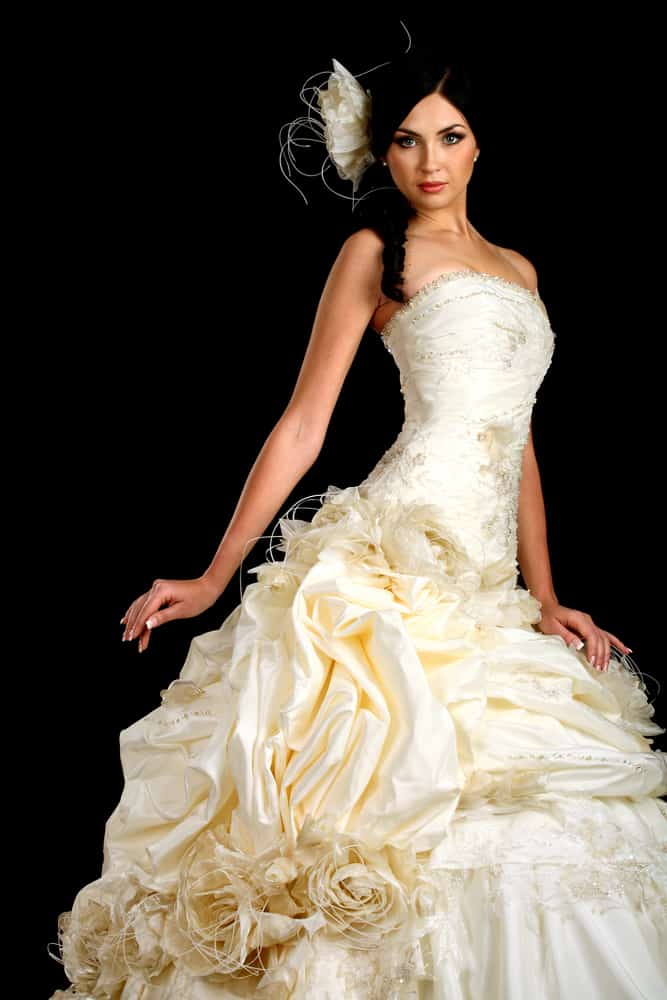
Royal wedding dresses ruled the 2010s and set the wedding fashion for the decade. There were multiple royal wedding dresses for the public to envy during the decade and wedding dress style changed with each new royal bride to march down the aisle. Royal weddings are even more talked-about than celebrity weddings, though celebrity weddings are also responsible for wedding trends and popular looks.
2011: When Kate Middleton gracefully marched down the aisle to wed Prince William in 2011, she set the wedding style trends for the rest of the decade. Kate’s long-sleeved, lacy white gown and matching custom veil became the envy of brides around the world.
Ruching was big in this decade. This is a gathering technique that creates soft folds in gowns and it was all the rage in wedding dresses because it’s an ultra-flattering look. Mermaid silhouettes were super trendy as well, along with strapless and cap sleeve looks. Big ball gown silhouettes were very en vogue, always a classic bridal look.
2018: Royal bride Meghan Markle stunned the world with her stunning white wedding dress. When Markle wed Prince Harry, she wore a simple, elegant white gown with a full skirt and long sleeves. It had an open bateau neckline, a look that Meghan Markle favors.
Princess Charlotte, daughter of Prince William and Kate Middleton, the Duke and Duchess of Cambridge, also caught headlines for her simple bridesmaid’s dress, which was designed to complement Meghan’s look. The adorable princess wore a simple white dress with short sleeves and a flared skirt…and stole hearts around the world.
The little princess made a splash at the royal wedding in 2018, but another Princess Charlotte is famous for the dress she wore to her wedding. That Princess Charlotte was wed in 1816 wearing a transparent dress that allowed her white and silver slip to show through. The dress was adorned with shells and bouquets and silver lame embroidery.
2020s

Wedding trends were turned upside-down in the 2020s, a decade that began with a pandemic and changed the entire world. More off-white gowns appeared in bridal fashion than ever before in this decade and gowns have a brand-new, edgy vibe. Black accents, low-cut spaghetti strap designs, high slits, and short skirts give dresses a distinct look in this decade. The edgy style is softened with lace.
A free-flowing, bohemian look is back in this decade. Many gowns have extra panels of fabric and long trains made with lightweight chiffon or lace. Bell sleeves, puffed sleeves, and asymmetrical sleeve looks are hot in this decade.
Princess Beatrice, daughter of Prince Andrew and granddaughter to Queen Elizabeth, embraced another trend at the beginning of the decade when she donned a vintage white gown for her nuptials. For her wedding attire, Princess Beatrice wore a modified encrusted taffeta gown that was originally worn by the Queen in the 1960s. The gown featured many trends of the decade, including the puffed chiffon sleeves and long chiffon train.
Today’s bride has no rules and no restrictions. Color is back in bridal fashion, silhouettes are made in all shapes and sizes and wedding attire is made to look as unique as the couples tying the knot on their wedding day.
References:
Bellatory: Women’s Fashions of the 1890s
Brides: 7 Decades of Wedding Dresses and How to Wear Them for Modern Times
Brides: The 8 Spring 2020 Wedding Dress Trends You Need to Know
Brides: Meghan Markle’s Wedding Dress: The Ultimate Guide
Brides: We Take a Look Back at Princess Margaret’s Wedding
Business Insider: Here’s how wedding dresses have changed over 200 years — and why
Business Insider: How wedding dresses have evolved over the last 100 years
CNN: Why so many brides wear white on their wedding day
Elle: The Evolution Of Bridal Style Through The Years
Ellie’s: Wedding Gowns & Trends of the Decade (2010-2019)
Family Search: 1900s Fashion: Clothing Styles in the Edwardian Era
Fashion-Era: 1910 – Late Edwardian Wedding Dress Pictures of Bride and Groups
Good Housekeeping: Princess Charlotte Stole the Show in an Adorable Givenchy Dress for the Royal Wedding
Harper’s Bazaar: These Are the Top Bridal Trends for 2020 Weddings
Historic UK: Honiton Lace
JSTOR Daily: A Natural History of the Wedding Dress
The Knot: Victorian Wedding Style
Livingly: ’90s Wedding Trends You Forgot About
Love to Know: History of Wedding Dresses
Love to Know: Women’s Fashion 1910s
Museum Center at 5ive Points: A Brief History of Western Fashion 1850-1900
National Trust: Princess Charlotte’s wedding
Town & Country: Princess Beatrice’s Stunning Vintage Wedding Dress Was Her “Something Old“
University of Vermont: Women’s Clothing
Vogue: Every Romantic Detail Of Note From Princess Anne’s Wedding




